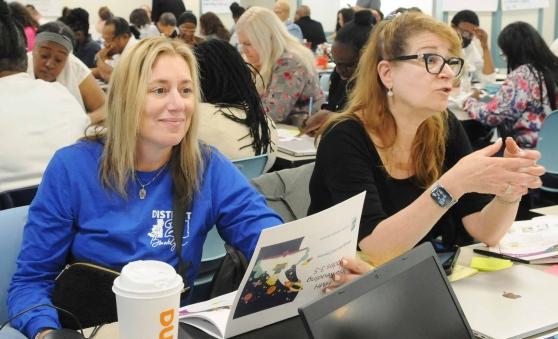
Chapter Leaders Lori Izen (left) from PS 225 in Brooklyn and Judy Kriegsman from PS 221 in Queens learn about the new reading curricula during a Teacher Center-led training session for principals and chapter leaders on May 23 at UFT headquarters.
In a major reset, New York City is overhauling how reading is taught in early childhood and elementary school settings in public schools throughout the city.
Over the next two years, elementary schools will be required to adopt one of three evidence-based literacy programs that are grounded in phonics: HMH Into Reading, Expeditionary Learning (EL) Education or Wit & Wisdom. All early childhood education classrooms will be required to adopt the Creative Curriculum.
“For 20 years now, the city’s policy has been that every school is on its own. That is no way to run a school system,” UFT President Michael Mulgrew said at the city Department of Education’s May 9 press conference, held at PS 156 in Brownsville, Brooklyn, to announce the new initiative.
Unlike most other large urban school districts, which use one literacy curriculum systemwide, in New York City, each principal has had the discretion to choose their school’s curriculum. Going forward, the community school district superintendent will pick one of the three research-backed curricula.
The approved curricula emphasize sounding out words and foundational literacy skills, which were neglected for the past two decades in many schools in favor of a whole language approach, which encourages word memorization and independent reading. As part of the new initiative, schools must phase out materials from Units of Study, the balanced literacy curriculum developed by Lucy Calkins, a professor at Teachers College at Columbia University.
The whole-language approach proved disastrous for many students, including those with learning differences, said Schools Chancellor David C. Banks.
During the press conference, both Mayor Eric Adams and Mulgrew shared that they are dyslexic and struggled with reading in elementary school.
Half of New York City public school students in grades 3–8 are not reading at grade level on reading tests, Banks noted. “They aren’t reading because we’ve been giving our schools and our educators a flawed playbook,” Banks said, “with overlapping, contradictory and sometimes flat-out bad guidance.”
The new reading curricula will be piloted in 15 community school districts in September and then rolled out to the remaining 17 districts in September 2024.
Mulgrew stressed that for the initiative to be successful, the DOE must fulfill its obligation to provide educators with appropriate professional development and resources aligned to the new curriculum.
“We said no more drive-by training,” he said. “It has to be embedded, and it has to be throughout the entire year.”
At the union’s urging, the UFT Teacher Center will play an integral role in the training to make sure teachers get the support they need, adapted to the students they teach.
“In true Teacher Center fashion, we are here to support educators in myriad ways, from implementation to supporting students with diverse needs,” said UFT Teacher Center Director Rosemarie LoMonaco. “We will continually review the training to make sure it meets the needs of educators.”
A new algebra curriculum will also be implemented in 178 high schools, spanning seven districts, starting in September. The new curriculum, Illustrative Mathematics, is for Algebra 1, typically offered in grade 9 and sometimes in grade 8.
Algebra is the focus because it is considered foundational to all higher-level math, said Christine Hanley, a field coordinator supporting mathematics at the UFT Teacher Center.
Illustrative Mathematics is an inquiry-based model, Hanley said, so content begins with a problem being posed and students engage in questioning and discussion to find the answer.